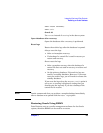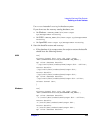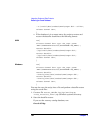
Integrating Oracle and Data Protector
Restoring an Oracle Database
Chapter 198
You can also save the script into a file and perform a full database restore
using the saved files. The procedure in such cases is as follows:
1. Create a file restore_database in the /var/opt/omni/tmp (UNIX
systems) or <Data_Protector_home>\tmp directory.
2. Start the full database restore:
If you use the recovery catalog database, run:
Oracle 9i/10g:
• On Windows: <ORACLE_HOME>\bin\rman target
sys/manager@PROD catalog rman/rman@CATAL
cmdfile=<Data_Protector_home>\tmp\restore_datafile
• On UNIX: <ORACLE_HOME>/bin/rman target sys/manager@PROD
catalog rman/rman@CATAL
cmdfile=/var/opt/omni/tmp/restore_datafile
Oracle 8i:
Use rcvcat instead of catalog in the above syntax.
If you do not use the recovery catalog database, run:
• On Windows: <ORACLE_HOME>\bin\rman target
sys/manager@PROD nocatalog
cmdfile=<Data_Protector_home>\tmp\restore_datafile
• On UNIX: <ORACLE_HOME>/bin/rman target sys/manager@PROD
nocatalog cmdfile=/var/opt/omni/tmp/restore_datafile
Example of Point-in-Time Restore
To perform a point-in-time restore, you also need to restore and apply the
archive logs to the specified point in time. To perform a point-in-time
database restore and recovery:
1. Log in to the Oracle RMAN:
If you use the recovery catalog database, run:
Oracle 9i/10g:
• On Windows: <ORACLE_HOME>\bin\rman target
sys/manager@PROD catalog rman/rman@CATAL
• On UNIX: <ORACLE_HOME>/bin/rman target sys/manager@PROD
catalog rman/rman@CATAL


















